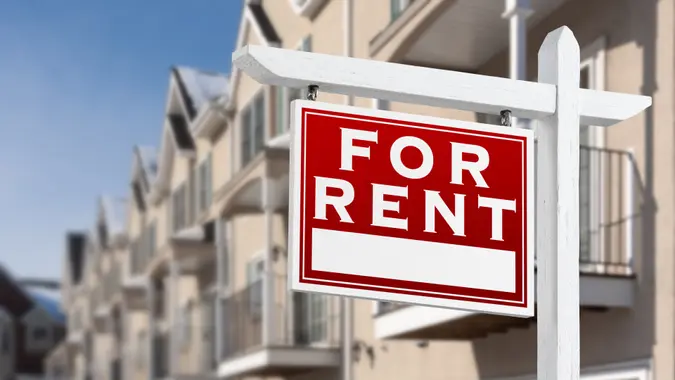This Is the 1 Florida City Where Almost No One Can Afford a House

Commitment to Our Readers
GOBankingRates' editorial team is committed to bringing you unbiased reviews and information. We use data-driven methodologies to evaluate financial products and services - our reviews and ratings are not influenced by advertisers. You can read more about our editorial guidelines and our products and services review methodology.

20 Years
Helping You Live Richer

Reviewed
by Experts

Trusted by
Millions of Readers
Like many people, you’ve probably scrolled through luxury housing offers on Zillow or Realtor.com and found the aspirational, over-the-top real estate to be more than slightly out of reach. For places like Miami Beach, Florida –which is synonymous with luxury living, world-class beaches and a place retirement dreams are made of — unless you’re a multimillionaire, you may have to rule out a move there.
In a recent study, GOBankingrates found Miami Beach to be one of the most exorbitantly priced cities, not only in Florida but also in the entire United States. Here are some key takeaways:
- Average monthly expenditures: $2,232
- Average home value: $2,590,906
- Average mortgage payment: $15,171
- Salary needed: $377,073
As beautiful as the South Florida spot is, the real estate and housing costs alone would make any potential buyer balk. Whether you’re eyeing a beachfront condo or a historic Art Deco home, the cost of property in Miami Beach is in large part astronomical.
Here are three reasons why nearly no one can afford a house there.
Location, Location, Location
You don’t have to be a real estate genius to deduce the high housing costs and the generally high cost of living in Miami Beach is attributed to its prime location.
This coastal city is a desirable destination for tourists, retirees and residents alike thanks to its year-round warm climate, pristine beaches and proximity to downtown Miami.
Being an island city means space is limited, and land scarcity drives up property prices. With limited land available for new development, existing properties become highly coveted, pushing prices even higher. This is why the monthly expenses of someone living there are estimated to be over $2,200.
What So Nice About a Luxury Housing Market?
Miami Beach has evolved into a luxury real estate market over the past few decades.
The city is home to high-end condos, multimillion dollar mansions and boutique residences with world-class amenities. High-profile developers have created exclusive communities where celebrities, business moguls and wealthy individuals snatch up properties like pieces of candy.
Real estate logic such as this is why you’ll need to be able to pay upwards of $15,000 a month just in mortgage payments. GOBankingRates found the average home value to be $2.6 million, and the average mortgage payment is about $15,171.
The Tourist Trap of Short-Term Rentals
Miami Beach is one of the most popular tourist destinations in Florida, drawing millions of visitors annually. As a result, the demand for vacation properties and short-term rentals has surged, especially with platforms like Airbnb making it easy for homeowners to rent out their properties.
Investors see real estate here as a lucrative opportunity due to its strong rental market. Many buyers purchase homes or condos with the intent of renting them out, which can not only cause a housing shortage but also up the rates you can expect to pay. This is just one of the many reasons you need an estimated salary of $377,073 just to be comfortable in Miami Beach.
Final Take To GO
The bottom line is that the high cost of real estate in Miami Beach is driven by a combination of factors, none of which appear to be going down anytime soon. Add in the rising demand for investment properties and the city’s efforts to combat climate change, and it’s clear why prices continue to rise.
Miami Beach is a great place, but just to visit for anyone on a budget.
Methodology: For this study, GOBankingRates analyzed the largest cities in Florida to find the average cost of utilities in each place. First, GOBankingRates found data for cities in Florida including: total population, population ages 65 and over, total households, and household median income — all sourced from the U.S. Census American Community Survey. For each city, several factors were found including: cost of living indexes as sourced from Sperlings BestPlaces, livability index as sourced from AreaVibes and the average single-family home values as sourced from Zillow Home Value Index from June 2024. By assuming a 10% down payment and using the national average 30-year fixed mortgage rate as sourced from the Federal Reserve Economic Data, the average mortgage cost can be calculated. The cost of living indexes can be used with the national average expenditure costs for all residents, as sourced from the Bureau of Labor Statistics Consumer Expenditure Survey, to find the average expenditure costs in each city. The Bureau of Labor Statistics Consumer Expenditure Survey uses numerous variables to determine the utilities cost including: electricity, natural or utility gas, fuel oil, bottled/tank gas, wood fuel, piped-in water and sewage, and garbage and recycling collection. The cities were sorted by their total population. All data was collected on and is up to date as of Jul. 31, 2024.
Methodology: To find out how rich you have to be to buy a house in the most populated Florida cities, GOBankingRates analyzed the top 60 cities in Florida in terms of population as sourced from the US Census American Consumer Survey. For each Florida city, a number of factors were found including: average home value for single-family homes in December 2023 as sourced from the Zillow Home Value Index, average national 30-year fixed mortgage rate, as sourced from the Federal Reserve Economic Research, grocery cost of living index, healthcare cost of living index, utilities cost of living index, transportation cost of living index, and miscellaneous cost of living index — all sourced from Sperlings BestPlaces, and average national expenditure costs for all consumers, as sourced from the Bureau of Labor Statistics Consumer Expenditure Survey. The average national expenditure costs and the cost-of-living indexes were used to calculate the average cost of living in each city. The average mortgage and the average expenditure costs were combined to give the total cost of needs. Using the 50/30/20 rule, the needs are calculated to be 50%, so doubling the needs cost gives the total salary needed to buy a house in the most populated Florida cities. All data was collected and is up-to-date as of May 31, 2024.
 Written by
Written by  Edited by
Edited by 

























